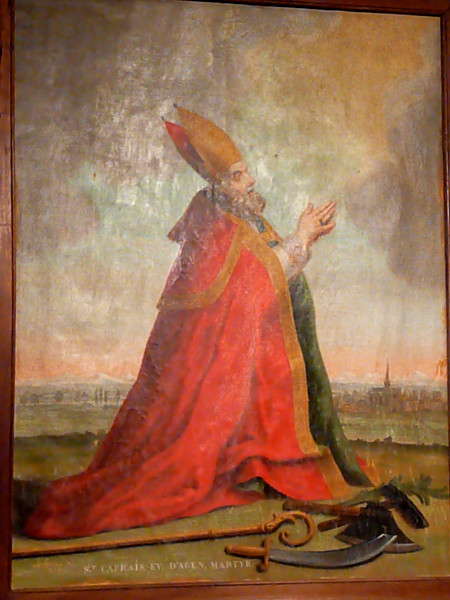This miracle gave Caprasius assurance that the Lord did indeed find him worthy of the crown of martyrdom, so he went to the city square and declared publicly for Christ. Spurning Dacian's offer of gifts if he were to recant, he was put to death. His example led others to confess their faith as well, including two brothers named Primus and Felicianus.
According to legend, the stream from the cave continued to flow perpetually in Agen.
One text says Caprasius was beheaded, another that his flesh was torn to pieces. The 19th-century painting at right shows him with a collection of instruments that seem to cover both possibilities – for beheading, a sword; for hacking, an axe and adze. Also on the ground is a martyr's palm. Although he is not listed as a bishop in the Roman Martyrology, he is shown here with a mitre and crozier because local tradition holds that he was the first bishop of Agen.1
The painting, by Jean-Baptiste Delmas, is in the Musée Fau in Conques. One would think that the city in the background should be Agen with its 12th-century cathedral, but the pointed spire in the picture is quite different from the square tower of the actual church (image) or the double towers in Conques (image).
Prepared in 2013 at Augusta University by Richard Stracke, Emeritus Professor of English
HOME PAGE

Saint Caprais d'Agen, Martyr
DATES
- Feast day: October 20
- Died 303 in some texts. Butler (IV, 155) and Sheingorn (287) think the 3rd century more likely.
NAMES
- In French he is Saint Caprais.
BIOGRAPHY
- Sheingorn, "The Passion of Sainte Foy" in The Book of Sainte Foy (35-36).
- Butler, IV, 155.
- Bokenham, "The Lyf of Seynt Feyth" in Legends of Holy Women (96-101 in Kölbing, 74-78 in Delany).
- "Seint Fides" in the Early South English Legendary (85-86).
- Acta Sanctorum, October vol. 8, 815-29.
ALSO SEE
NOTES
1 Roman Martyrology, February, 23. Sheingorn, 287, note 2.